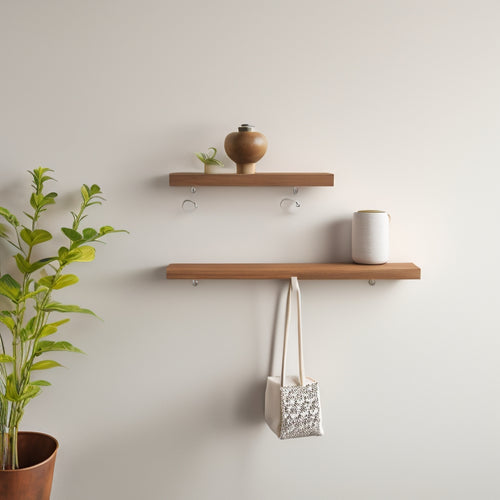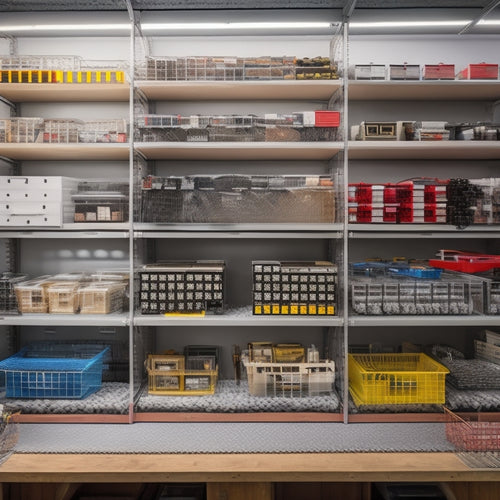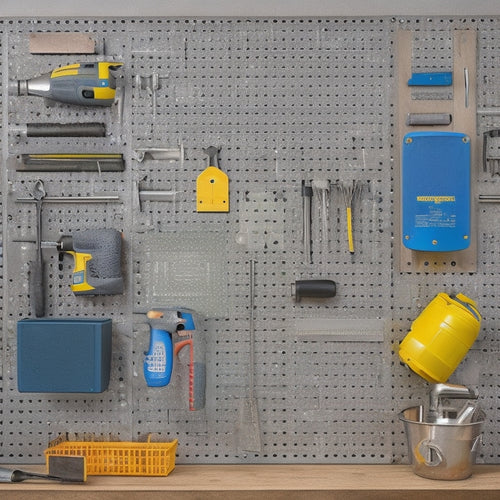
What Makes a Good Compact Tool Storage Container?
Share
When shopping for a compact tool storage container, you should prioritize durable construction materials that can withstand harsh environments and frequent use. Look for high-quality materials like heavy-duty plastics, stainless steel, and aluminum, as well as features like reinforced corners, rust-resistant hinges, and secure latches. A well-organized design with adjustable compartments, dividers, and labeling will also maximize storage capacity and minimize clutter. Additionally, consider portability features like lightweight construction, ergonomic handles, and secure closure systems. By evaluating these key factors, you'll find a container that meets your needs and takes your workspace to the next level - and there's more to investigate to guarantee you make the best choice.
Key Takeaways
- A good compact tool storage container should be made with durable construction materials that can withstand harsh environments and frequent use.
- It should have a space-efficient design with adjustable compartments, dividers, and labeling to keep tools organized and easily accessible.
- The container should be portable and mobile, with features like lightweight construction, ergonomic handles, and secure grip design.
- A reliable and secure closure and latch system is essential to prevent unauthorized access and protect tools from environmental elements.
- The container should be weather-resistant, with a focus on rust and corrosion protection, to maintain the condition and usability of tools over time.
Durable Construction Materials Matter
When it comes to a good compact tool storage container, you're looking for one that can withstand the rigors of your workspace or job site, and that's where durable construction materials come into play. You need a container that can resist corrosion, abrasion, and impact, guaranteeing your tools remain protected and organized.
Durable construction materials directly affect the container's construction longevity, which is essential for withstanding harsh environments and frequent use.
Material variety is also vital in determining the container's overall durability. Look for containers made from high-quality materials like heavy-duty plastics, stainless steel, or aluminum. These materials offer superior strength, resistance to corrosion, and can withstand extreme temperatures.
Additionally, consider containers with reinforced corners, rust-resistant hinges, and secure latches to guarantee your tools remain safe and secure. By choosing a container with durable construction materials, you can trust that your tools will be protected, and your workspace will remain organized and efficient.
Space Efficiency Is Key Factor
Your workspace is likely cluttered with tools, equipment, and materials, making it essential to optimize storage space. A good compact tool storage container should be designed with space efficiency in mind. You need a container that can store a maximum number of tools in a minimal amount of space, without compromising accessibility.
When choosing a compact tool storage container, consider the following factors:
| Feature | Description | Importance |
|---|---|---|
| Compact design | The container's dimensions and shape should maximize storage capacity while minimizing floor space. | High |
| Adjustable compartments | Compartments that can be adjusted to fit different tool sizes and types allow for more efficient storage. | Medium |
| Stackability | Containers that can be stacked on top of each other save floor space and reduce clutter. | High |
| Tool organization | The container should have features that keep tools organized, such as dividers or small compartments, to reduce time spent searching for tools. | Medium |
| User preferences | The container should be customizable to fit your specific needs and preferences. | High |
Organizational Design Is Crucial
You'll want to contemplate a tool storage container with an organizational design that lets you access and see your tools quickly, so you can grab what you need in a flash.
A space-efficient layout design is also vital, as it guarantees that every inch of the container is used wisely.
Tool Access and Visibility
A well-designed tool storage container's organizational layout plays an essential role in facilitating effortless tool access and visibility. You want to be able to quickly and easily locate the tool you need, without having to dig through a cluttered container. A well-organized layout guarantees that you can identify the tool you need at a glance, making tool retrieval faster and more efficient.
To achieve this, consider the following design elements:
| Design Element | Description | Benefit |
|---|---|---|
| Clear Compartmentalization | Divide the container into separate compartments | Easier item identification |
| Labeling and Signage | Label each compartment and tool | Faster tool retrieval |
| Tool Orientation | Store tools in an upright position | Reduced clutter and improved visibility |
| Tiered Storage | Use stacked trays or shelves | Increased storage capacity |
| Open Shelving | Leave some shelves open for frequently used tools | Quick access to frequently used tools |
Space-Efficient Layout Design
Optimizing the tool storage container's layout is vital to maximizing storage capacity while maintaining easy tool access. You want to make the most of the available space without sacrificing the ability to quickly find and retrieve the tools you need. A well-designed layout guarantees that each tool has a designated spot, reducing clutter and the risk of damage.
A stackable design is fundamental in achieving a space-efficient layout. This feature allows you to add or remove layers as needed, providing flexibility and adaptability to your storage needs.
Modular components are also important, as they enable you to customize the container's internal configuration to fit your specific tools and equipment. This modular approach guarantees that each tool is stored in a designated area, making it easy to locate and access.
When designing the layout, consider the frequency of use and the size of each tool. Store frequently used tools in easy-to-reach locations, and reserve lower or harder-to-reach areas for less frequently used items.
Portability and Mobility Features
Its compact design and lightweight construction make your tool storage container easy to carry around the job site or in your vehicle, allowing you to transport your essential tools wherever they're needed.
You'll appreciate the convenience of being able to move your tools quickly and effortlessly, without straining your back or shoulders. The lightweight design guarantees that you can easily lift and maneuver the container, even when it's fully loaded.
Ergonomic handles are another vital feature that enhances portability. Designed to fit comfortably in your hand, these handles distribute the weight of the container evenly, reducing fatigue and discomfort.
You can grip them securely, even with gloves on, and maintain control as you traverse through tight spaces or uneven terrain. Whether you're working on a construction site, in a garage, or on the go, your tool storage container should be able to keep up with your fast-paced environment.
With its portable and mobile design, you can focus on getting the job done efficiently and safely.
Secure Closure and Latch System
With your tools safely stowed away, you need a secure closure and latch system to guarantee they remain organized and within reach, yet protected from theft or loss.
A good compact tool storage container should have a reliable latch mechanism that keeps the lid shut tightly, even when you're on the move. Look for containers with secure locking systems, such as padlocks or combination locks, to prevent unauthorized access. The latch system should be sturdy and able to withstand rough handling.
Additionally, consider a container with a reinforced lid and strengthened hinges to prevent forced entry. The closure system should be easy to use, even with gloves on, and shouldn't require too much effort to open or close.
A secure closure and latch system provides peace of mind, allowing you to focus on the task at hand, knowing your tools are safely stored away. By investing in a container with a reliable latch mechanism and secure locking, you're protecting your important tools and equipment from potential theft or loss.
Weather Resistance and Durability
When choosing a compact tool storage container, you'll want to reflect on how well it can withstand the elements.
The material it's made of, the design of its seals and closures, and its rust and corrosion protection all play critical roles in determining its weather resistance and durability.
Material Selection Matters
You'll likely need your compact tool storage container to withstand the elements, so material selection becomes critical. A good container should be able to resist harsh weather conditions, such as rain, snow, or extreme temperatures, to protect your precious tools.
When selecting a material, consider the following key factors:
-
Water resistance: Look for materials with a water-resistant coating or treatment to prevent water from seeping into the container.
-
UV resistance: Choose materials that can withstand exposure to direct sunlight without degrading or becoming brittle.
-
Chemical resistance: Select materials that can resist corrosion or damage from chemicals or fuels commonly found in workshops or job sites.
A durable and weather-resistant container guarantees your tools remain safe and secure.
Additionally, a container with user-friendly features, such as an ergonomic design, can provide easy access and handling, making it a significant asset for any professional or DIYer.
Seal and Closure Design
A good seal and closure design is crucial to maintaining the integrity of your compact tool storage container, as it serves as the first line of defense against the elements. You need to verify that your container can withstand harsh weather conditions, such as rain, snow, or extreme temperatures. A reliable seal will prevent water and moisture from entering the container, which can damage your tools and equipment.
There are various seal types to evaluate, including O-rings, gaskets, and foam inserts. Each type has its own strengths and weaknesses, and you should choose the one that best suits your needs. For example, O-rings are effective in sealing small gaps, while gaskets provide a more thorough seal.
The closure mechanism is also critical in maintaining the container's integrity. You should look for mechanisms that are easy to use, yet provide a secure seal. Latches, clasps, and buckles are common closure mechanisms used in compact tool storage containers.
Assess a mechanism that can be easily locked to prevent unauthorized access to your tools and equipment. By choosing the right seal and closure design, you can verify your tools remain safe and protected from the elements.
Rust and Corrosion Protection
By the time you've invested in a compact tool storage container, you expect it to protect your prized tools and equipment from the elements. After all, you've spent a significant amount of money on those tools, and you want them to remain in top condition.
Rust and corrosion can quickly render your tools useless, which is why it's crucial to choose a storage container that offers strong rust and corrosion protection.
-
Look for containers with rust inhibitors, such as coatings or liners, that prevent moisture from coming into contact with your tools.
-
Confirm the container is made from corrosion-resistant materials, such as stainless steel or durable plastics, that can withstand exposure to the elements.
-
Check if the container has drainage holes or a sloping bottom to prevent water from accumulating inside, which can accelerate rust and corrosion.
A good compact tool storage container should be designed to keep your tools safe from the elements, not just store them.
Customization and Adaptability Options
Flexibility is key when it comes to tool storage, and the ability to customize and adapt your container to your specific needs is crucial.
You need a system that can evolve with your tool collection and accommodate new additions or changes. Look for containers with custom inserts that allow you to create a personalized layout for your tools.
Adjustable dividers will also help you maximize storage space and keep your tools organized. Modular designs are another great feature, as they enable you to add or remove components as needed.
Customized labels can further enhance your storage system, making it easy to identify what's inside each compartment. Multi-functional compartments can also help you make the most of your storage space.
When choosing a compact tool storage container, consider the manufacturer's commitment to user feedback and continuous improvement. This guarantees that the product is refined and adapted to meet the needs of users like you.
Affordability and Value for Money
When evaluating the affordability of a compact tool storage container, you should consider three key factors: its initial purchase price, ongoing maintenance costs, and overall value for money.
- Be wary of extremely low prices that may indicate a low-quality product.
- Look for containers with durable materials and construction to minimize replacement costs.
- Calculate the total cost of ownership, including any additional features or accessories you may need.
A good compact tool storage container is a long-term investment, and you should approach it in that manner. Instead of focusing solely on the initial purchase price, consider the potential savings it can offer in the long run.
For instance, a high-quality container with rust-resistant materials may cost more upfront, but it can save you money in the long run by reducing the need for frequent replacements.
Make a price comparison between different products, and choose the one that offers the best value for your money. By doing so, you can guarantee that your compact tool storage container remains a safe and reliable companion for your tools and equipment.
Frequently Asked Questions
Can Compact Tool Storage Containers Be Used for Non-Tool Items?
You can definitely use compact tool storage containers for non-tool items, as they offer versatile storage and organization solutions, allowing you to safely store and access anything from craft supplies to first-aid kits, and more.
Are Compact Tool Storage Containers Suitable for Outdoor Use Only?
You need a compact tool storage container that can withstand harsh outdoor conditions, so look for one with outdoor durability and weather resistance features, such as waterproof seals, rust-proof materials, and UV protection to guarantee your items stay safe and secure.
Do Compact Tool Storage Containers Require Assembly or Maintenance?
You'll find that most compact tool storage containers come pre-assembled, but you'll still need to check the assembly requirements before use. Additionally, follow maintenance tips like cleaning and lubricating hinges to guarantee smooth operation and extend the container's lifespan.
Can Compact Tool Storage Containers Be Mounted on Walls or Ceilings?
You're wondering if you can hang that compact tool storage container on the wall or ceiling, right? Well, the answer is yes, many offer versatile mounting options, ensuring wall compatibility and secure storage, giving you the freedom to optimize your workspace!
Are Compact Tool Storage Containers Available in Various Sizes and Shapes?
You'll find compact tool storage containers come in various sizes and shapes, offering design features that cater to your specific needs, while their material durability guarantees a safe and sturdy storage solution for your tools.
Conclusion
You've got a compact tool storage container on your mind, but you're hesitant to invest in one that might not meet your needs. Don't worry, a good compact tool storage container is worth the investment. You might think, "I can just use an old box or bin," but a purpose-built container will keep your tools organized, protected, and within reach, saving you time and hassle in the long run. By considering the key factors outlined above, you'll find a container that pays for itself through increased productivity and reduced frustration.
Related Posts
-

Wall Mounted Hooks With Shelf for Maximum Storage
You'll find that wall mounted hooks with a shelf are a revolutionary solution for maximizing storage in your home, pr...
-

10 Essential Steps for Small Parts Bin Storage
To optimize your small parts bin storage, start by defining your storage needs and goals, considering factors like av...
-

How to Hang a Pegboard in 5 Easy Steps
You'll hang a pegboard in 5 easy steps by first preparing the wall, ensuring it's sturdy and free of obstructions. Ne...


